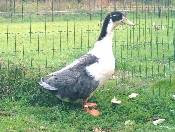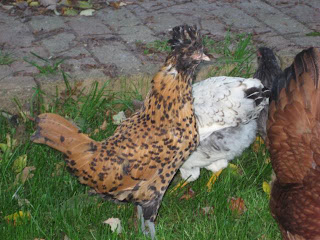 |
| Drawing of a a pair of Huttegem ducks by René Delin, 1925 Photo Source: Courtesy of the Association for the Promotion of Belgian Poultry Breeds |
The Huttegem or Oudenaarde Duck is a very old historic breed whose origins lay in the Oudenaarde region of Belgium.
| Oudenaarde Region of Belgium |
It is said that during the late 1800’s and early 1900’s, it was a very popular duck kept in large numbers, especially along the Scheldt River. Of its ancestry, nothing is really known although it is speculated that it is a progeny of crosses involving the Termonde duck.
 |
| Termonde Ducks - Blue Pair Photo Source: Bedreigd Belgische Neerhofdieren |
In 1909, British poultry specialist J. T. Brown was visiting the Oudenaarde region and was quite taken with the blue Huttegem. It is suggested that he was able to secure some stock and take back with him to Britain where it supposedly became one of the ancestors of the Magpie duck.
 |
| J. T. Brown Demonstrating Thermometer Reading from an Incubator Photo Source: Chest of Books |
The Huttegem was originally kept as a laying breed in flocks of great numbers, usually along river banks and streams. The ducks were known for their winter laying ability. Gradually the farmers, noting that they would be able to raise ducklings to a good slaughter size by Easter, began to use the Huttegem more and more for the production of meat.
Like Indian Runner ducks and other breeds that have been bred primarily for egg-laying abilities, the Huttegem was not known for its brooding abilities. The farmers were able to solve this problem by having the eggs brooded by a large local chicken breed, also known by the name of Huttegem. As was customary throughout Europe, animals were often named for their locales, thus you could have several species of the same name.
Huttegem chickens were quite large and known for their broodiness. The hens could easily sit on a large number of duck eggs and they were also used for rearing the ducklings. As many as fifty ducklings were often placed under the care of just one hen.
 |
| Chicken Stepmother with Ducklings Photo Source: Christies Auction |
Common practice was for the hens to be placed in special cages from which they could not leave. These cages were basically some straw huts or wicker boxes with an open front. The hen was attached by her leg to a pole. The ducklings, however, could leave the ‘cages’ and go searching for other food, but they would never stray too far from their stepmothers. Then, when they reached the desired size, they were either placed with the breeding flock or were sent off too market.
The Huttegem, although an historic breed, was not accorded any official recognition until 1971 when the first Breed Standard was drawn up. According to the Standard, the Huttegem is a medium-sized duck of about 2 to 2.5 kg. Their body carriage is held in a rather upright position. Even though there were apparently several colors of the breed – black and white and blue and white pied varieties being the most common - only the blue and white pied pattern is mentioned in the Standard. This pattern consists of the neck, the breast and the primaries being white and the rest of the plumage being blue. Birds bred must have head markings similar to those found on the Fawn and White Indian Runner. The bill colour is slate while the legs and feet are a reddish-orange with black flecking.
 |
| Female Huttegem Duck Photo Source: © Jef Aerts - Steunpunt Levend Erfgoed |
The current status of the Huttegem is that it is extremely rare and possibly even extinct. There were a few breeders in the early 1970’s, but as of today, no individual of the breed has been found although hope lay in the possibility that somewhere a few remaining birds are being taken care of in somebody’s small flock. If so, it is possible that the breed can be reestablished, but currently, it appears that we are to late to save this historic breed; a tragic ending for a breed that is described in almost every historical book on duck keeping all over the world.
 |
| Huttegem Duck Photo Source: Unknown |
If you know of anyone keeping this duck, please contact:
The Association for the Promotion of Belgian Poultry Breeds (neerhofdieren@hotmail.com)
or
The Waterfowl Association
(http://www.watervogelbond.be/nl/)














































